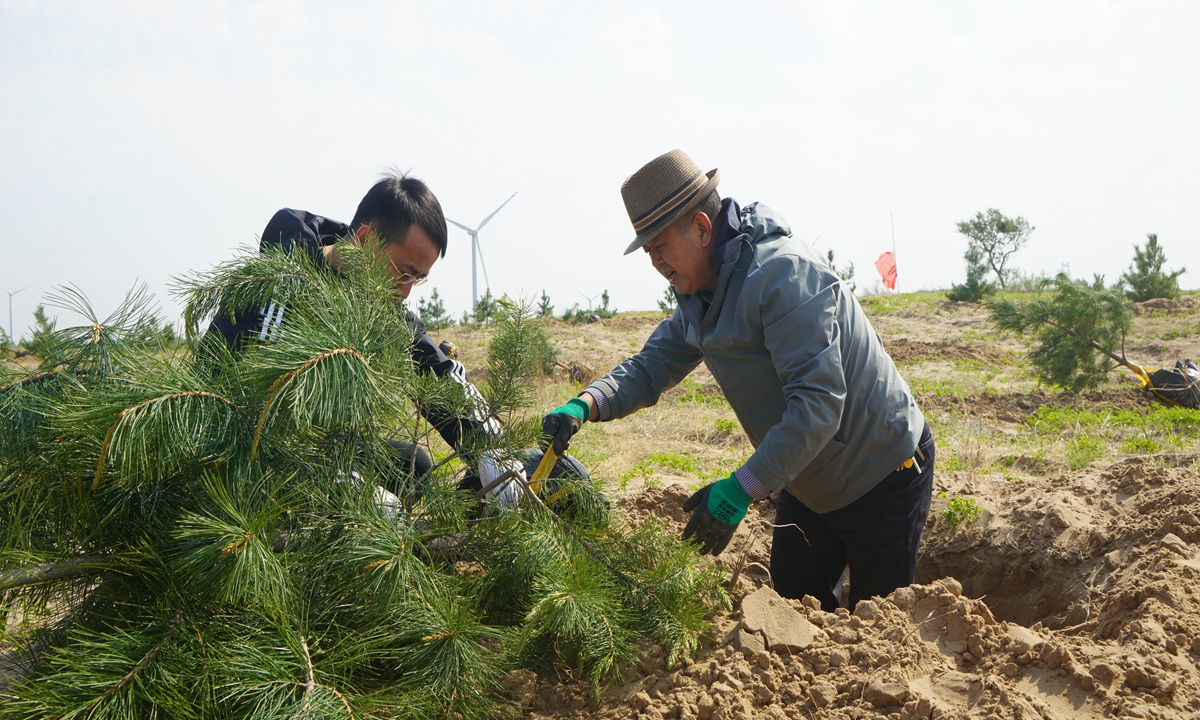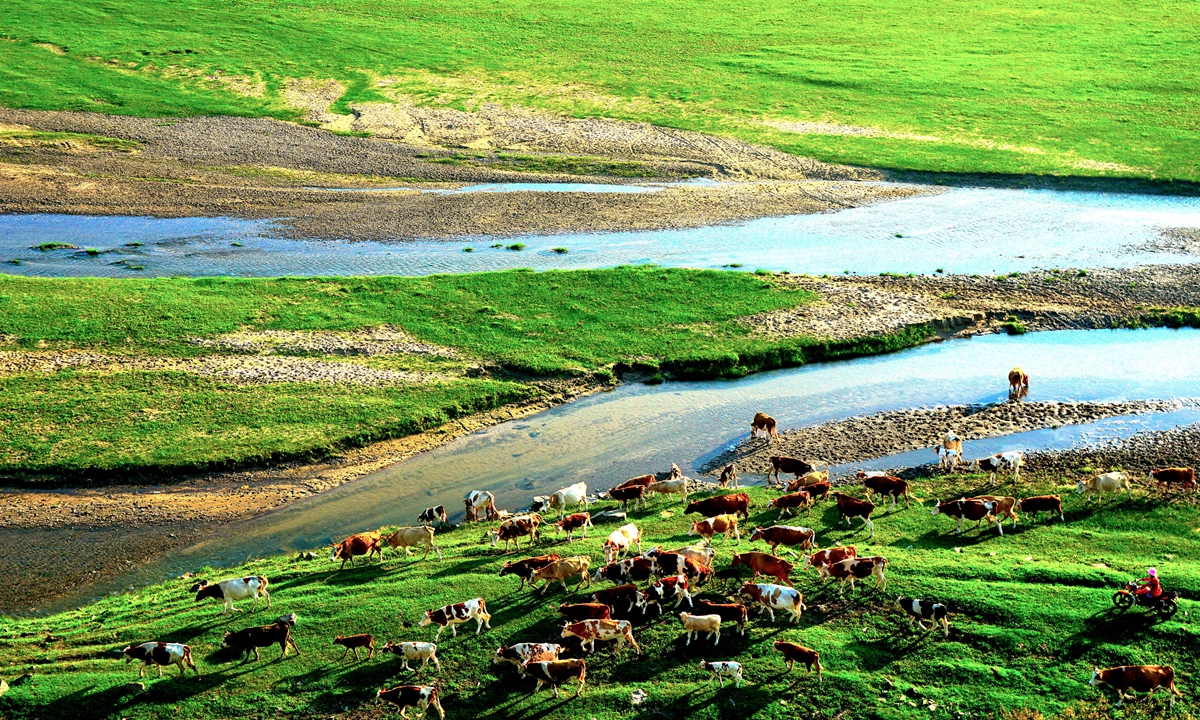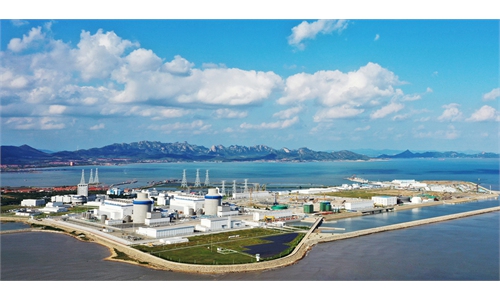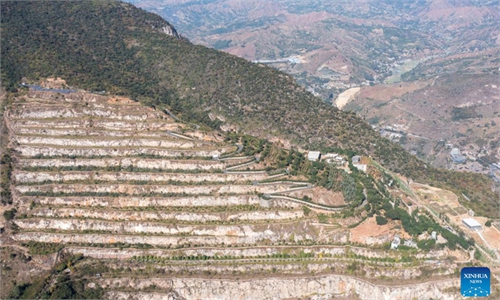Chinese Dream resonates with historical transformation of desert into an oasis on northern border of China
Editor's Note:
A decade ago, Chinese President Xi Jinping, also general secretary of the Communist Party of China (CPC) Central Committee and chairman of the Central Military Commission, put forward the Chinese Dream which envisages the brilliant future of the Chinese nation. The Chinese Dream is about pursuing strength of the country, rejuvenation of the nation and happiness of the people. Over the decade under the leadership of the CPC Central Committee with Comrade Xi at the core, Chinese people have made unremitting efforts and taken great strides toward realizing the Chinese Dream of national rejuvenation while enjoying tangible benefits from a prosperous and fast-growing country. In this series which tries to unpack the concept of the Chinese Dream through specific stories and anecdotes, the Global Times reporters talked to ordinary Chinese citizens - an aerospace engineer participating in the launch of China's first space station, a grassroots official dedicated to rural revitalization, an environmental warrior combating desertification in the Gobi desert, an artist promoting traditional Chinese culture, as well as a worker at a Belt and Road Initiative (BRI) project overseas - to see how the Chinese Dream inspires the nation and the world. This is the second installment of the series.

The dream of this Mongolian forestry worker also resonates with the dreams of hundreds of millions of people in China.
With the Chinese Dream in mind, the vision of Chaoketu's dream coming true is becoming clearer: Over the last decade, the Horqin Grassland has transformed from salvage protection to sustainable restoration, the rate of restoration overtaking that of desertification, reversing the passive situation of desert encroachment on human territory to a strategic advantage of gradual green field expansion. In China's northern border, a green tree ecological security barrier has firmly been put in place.

Currently, the forestry workstation in the Horqin Left Wing Rear Banner is bustling with activity with staff members busy planning the upcoming spring's forestry grass seeding.
"But in the past, spring was our most worrying season when sand often filled the sky and the seeds would be blown out the day after they had been planted. Farmers and herdsmen were full of despair in the face of barren land and their meager income," Chaoketu told the Global Times.
The Horqin Grassland, also known as the Horqin Sandy Land, is the largest sandy land in China. Due to climate change, encroachment, and over-grazing, the ecological environment suffered serious damage, becoming a leading cause of wind-sand in North China.
The Horqin Left Wing Rear Banner is located in the hinterland of the Horqin Sandy Land. In the early 1990s, the desertification of the banner was serious, with high winds, drought, and a lack of water, resulting in a survival rate of less than 50 percent of seedlings planted in the sands.
In 1991, Chaoketu graduated from a local forestry college and was assigned to work in the forestry workstation in the Horqin Left Wing Rear Banner. "At that time, I kept questioning in my heart until when we would see hope in such a desertified land," he said, "But I told myself that I could not retreat, and that I must have a dream, and then operate practically toward this goal, so that we could change our destiny."
The good news is that after a lifetime of fighting against the wind and sand, in the last decade, Chaoketu has seen tremendous changes taking place in the region.
Since the 18th National Congress of the CPC in 2012 first proposed the Beautiful China initiative, and the building of an ecological civilization was included in the national five-pronged overall plan, many regions in Chine have been transformed. Five years later, at the 19th CPC National Congress, Xi stressed the need to speed up reform on the ecological civilization system in order to build a beautiful China.
Over the past decade, the country's ecological conservation efforts have been in full swing. Among them, Tongliao has comprehensively implemented the new development concept which strengthens the efforts to improve the ecological environment, and strives to fundamentally improve the quality of life of residents. In 2014, the city implemented a series of measures in the Horqin Grassland, including afforestation and grass planting and banning unchecked logging and grazing. In this sustainable ecological restoration campaign, Chaoketu conducted in-depth field inspections in the sand areas, carefully designing and presiding over the completion of local desertification control and afforestation program planning.
Even though he has become the director of the forestry station, Chaoketu has always maintained his decades-long work habit - waking up early, wearing a straw hat, and carrying along a shovel to check the growth of saplings. In the fields, he has witnessed the Horqin Left Wing Rear Banner making up for some of its ecological shortcomings.
Since 2014, the banner has solidly carried out large-scale ecological rejuvenation at the rate of treating 1 million mu (66,666.7 hectares) of land and the planting of 16 million plants annually, where the forest coverage rate has reached 21.68 percent at present from 7 percent in the early 1990s, at an increase of 14.68 percent.
The dramatic historical change of the Horqin Left Wing Rear Banner is just a microcosm of China's green miracle.
In the last decade, China's forest expansion exceeded 70 million hectares, ranking first in the world. Data from the Ministry of Ecology and Environment show that in 2021, the average PM2.5 concentration in cities at or above the prefecture level nationwide dropped to 30 µg/m3, a 34.8 percent decrease from 2015.
Growing ecological confidence
In the Horqin Left Wing Rear Banner, the improvement of the natural environment has allowed people to fully enjoy the ecological dividends, and have a deep understanding of the phrase "Lucid waters and lush mountains are invaluable assets."
Chaoketu pointed out that in the past, in the process of promoting grassland ecological restoration, some farmers and herders initially disagreed with the government's phased ban on grazing and other binding initiatives. "But seeing tangible changes in the environment they live in, people gradually began to understand the efforts made by the government and became more actively involved in this ecological improvement campaign," he said.
With the outstanding results of ecological protection and the continuous strengthening of green development regulations and policy protection, the relevant departments of the banner have also actively changed the economic growth mode and have vigorously developed ecological agriculture.
At present, the Horqin Left Wing Rear Banner has developed a 300,000 mu of fruit-tree economic forest, 30,000 mu of seedlings and flowers and other ecological industry bases, accumulating economic benefits of more than 180 million yuan ($ 25.8 million). The forest and fruit industry is becoming a new growth point for farmers' and herdsmen's income.
As China's forest area continues to increase, ecotourism, forest recreation, a forest economy, and other green industries are flourishing. By 2020, the total output value of the national forestry industry had reaches 7.55 trillion yuan, creating jobs for 34 million people.
After 32 years of planting trees, the 56-year-old Chaoketu now sports tan skin and his palms are as rough as the bark of the camphor pine trees he has planted over the years, but he feels that his dream has been realized, and all this effort has been well worth it. He is also pleased to see that more tall, sunny young people are engaged in his career, inheriting the strong sense of hard work and diligence from their predecessors, with more advanced technical means.
For his next step, Chaoketu hopes to train more people before he retires, so that the green land will continue to increase across the vast territory of China.
Spring is approaching, and Chaoketu, who has fulfilled his dream, is full of expectations to seeing more trees sprouting on the Horqin Grassland.
A decade ago, Chinese President Xi Jinping, also general secretary of the Communist Party of China (CPC) Central Committee and chairman of the Central Military Commission, put forward the Chinese Dream which envisages the brilliant future of the Chinese nation. The Chinese Dream is about pursuing strength of the country, rejuvenation of the nation and happiness of the people. Over the decade under the leadership of the CPC Central Committee with Comrade Xi at the core, Chinese people have made unremitting efforts and taken great strides toward realizing the Chinese Dream of national rejuvenation while enjoying tangible benefits from a prosperous and fast-growing country. In this series which tries to unpack the concept of the Chinese Dream through specific stories and anecdotes, the Global Times reporters talked to ordinary Chinese citizens - an aerospace engineer participating in the launch of China's first space station, a grassroots official dedicated to rural revitalization, an environmental warrior combating desertification in the Gobi desert, an artist promoting traditional Chinese culture, as well as a worker at a Belt and Road Initiative (BRI) project overseas - to see how the Chinese Dream inspires the nation and the world. This is the second installment of the series.

Chaoketu (right) plants trees in the Horqin Grassland. Photo: Courtesy of Chaoketu
Carrying saplings in straw hat is just one sign of Chaoketu's year-round afforestation efforts as the director of the forestry workstation in Horqin Left Wing Rear Banner in Tongliao, North China's Inner Mongolia Autonomous Region. There are many considerations that Chaoketu has to make including the transplantation of the appropriate species of tree for the right kind of land in the ecological conservation plan for the banner, but his dream remains only one: To transform his hometown from a desert to an oasis.The dream of this Mongolian forestry worker also resonates with the dreams of hundreds of millions of people in China.
With the Chinese Dream in mind, the vision of Chaoketu's dream coming true is becoming clearer: Over the last decade, the Horqin Grassland has transformed from salvage protection to sustainable restoration, the rate of restoration overtaking that of desertification, reversing the passive situation of desert encroachment on human territory to a strategic advantage of gradual green field expansion. In China's northern border, a green tree ecological security barrier has firmly been put in place.

A view of the Horqin Grassland, North China's Inner Mongolia Autonomous Region Photo: cnsphoto
Green miracleCurrently, the forestry workstation in the Horqin Left Wing Rear Banner is bustling with activity with staff members busy planning the upcoming spring's forestry grass seeding.
"But in the past, spring was our most worrying season when sand often filled the sky and the seeds would be blown out the day after they had been planted. Farmers and herdsmen were full of despair in the face of barren land and their meager income," Chaoketu told the Global Times.
The Horqin Grassland, also known as the Horqin Sandy Land, is the largest sandy land in China. Due to climate change, encroachment, and over-grazing, the ecological environment suffered serious damage, becoming a leading cause of wind-sand in North China.
The Horqin Left Wing Rear Banner is located in the hinterland of the Horqin Sandy Land. In the early 1990s, the desertification of the banner was serious, with high winds, drought, and a lack of water, resulting in a survival rate of less than 50 percent of seedlings planted in the sands.
In 1991, Chaoketu graduated from a local forestry college and was assigned to work in the forestry workstation in the Horqin Left Wing Rear Banner. "At that time, I kept questioning in my heart until when we would see hope in such a desertified land," he said, "But I told myself that I could not retreat, and that I must have a dream, and then operate practically toward this goal, so that we could change our destiny."
The good news is that after a lifetime of fighting against the wind and sand, in the last decade, Chaoketu has seen tremendous changes taking place in the region.
Since the 18th National Congress of the CPC in 2012 first proposed the Beautiful China initiative, and the building of an ecological civilization was included in the national five-pronged overall plan, many regions in Chine have been transformed. Five years later, at the 19th CPC National Congress, Xi stressed the need to speed up reform on the ecological civilization system in order to build a beautiful China.
Over the past decade, the country's ecological conservation efforts have been in full swing. Among them, Tongliao has comprehensively implemented the new development concept which strengthens the efforts to improve the ecological environment, and strives to fundamentally improve the quality of life of residents. In 2014, the city implemented a series of measures in the Horqin Grassland, including afforestation and grass planting and banning unchecked logging and grazing. In this sustainable ecological restoration campaign, Chaoketu conducted in-depth field inspections in the sand areas, carefully designing and presiding over the completion of local desertification control and afforestation program planning.
Even though he has become the director of the forestry station, Chaoketu has always maintained his decades-long work habit - waking up early, wearing a straw hat, and carrying along a shovel to check the growth of saplings. In the fields, he has witnessed the Horqin Left Wing Rear Banner making up for some of its ecological shortcomings.
Since 2014, the banner has solidly carried out large-scale ecological rejuvenation at the rate of treating 1 million mu (66,666.7 hectares) of land and the planting of 16 million plants annually, where the forest coverage rate has reached 21.68 percent at present from 7 percent in the early 1990s, at an increase of 14.68 percent.
The dramatic historical change of the Horqin Left Wing Rear Banner is just a microcosm of China's green miracle.
In the last decade, China's forest expansion exceeded 70 million hectares, ranking first in the world. Data from the Ministry of Ecology and Environment show that in 2021, the average PM2.5 concentration in cities at or above the prefecture level nationwide dropped to 30 µg/m3, a 34.8 percent decrease from 2015.
Growing ecological confidence
In the Horqin Left Wing Rear Banner, the improvement of the natural environment has allowed people to fully enjoy the ecological dividends, and have a deep understanding of the phrase "Lucid waters and lush mountains are invaluable assets."
Chaoketu pointed out that in the past, in the process of promoting grassland ecological restoration, some farmers and herders initially disagreed with the government's phased ban on grazing and other binding initiatives. "But seeing tangible changes in the environment they live in, people gradually began to understand the efforts made by the government and became more actively involved in this ecological improvement campaign," he said.
With the outstanding results of ecological protection and the continuous strengthening of green development regulations and policy protection, the relevant departments of the banner have also actively changed the economic growth mode and have vigorously developed ecological agriculture.
At present, the Horqin Left Wing Rear Banner has developed a 300,000 mu of fruit-tree economic forest, 30,000 mu of seedlings and flowers and other ecological industry bases, accumulating economic benefits of more than 180 million yuan ($ 25.8 million). The forest and fruit industry is becoming a new growth point for farmers' and herdsmen's income.
As China's forest area continues to increase, ecotourism, forest recreation, a forest economy, and other green industries are flourishing. By 2020, the total output value of the national forestry industry had reaches 7.55 trillion yuan, creating jobs for 34 million people.
After 32 years of planting trees, the 56-year-old Chaoketu now sports tan skin and his palms are as rough as the bark of the camphor pine trees he has planted over the years, but he feels that his dream has been realized, and all this effort has been well worth it. He is also pleased to see that more tall, sunny young people are engaged in his career, inheriting the strong sense of hard work and diligence from their predecessors, with more advanced technical means.
For his next step, Chaoketu hopes to train more people before he retires, so that the green land will continue to increase across the vast territory of China.
Spring is approaching, and Chaoketu, who has fulfilled his dream, is full of expectations to seeing more trees sprouting on the Horqin Grassland.


